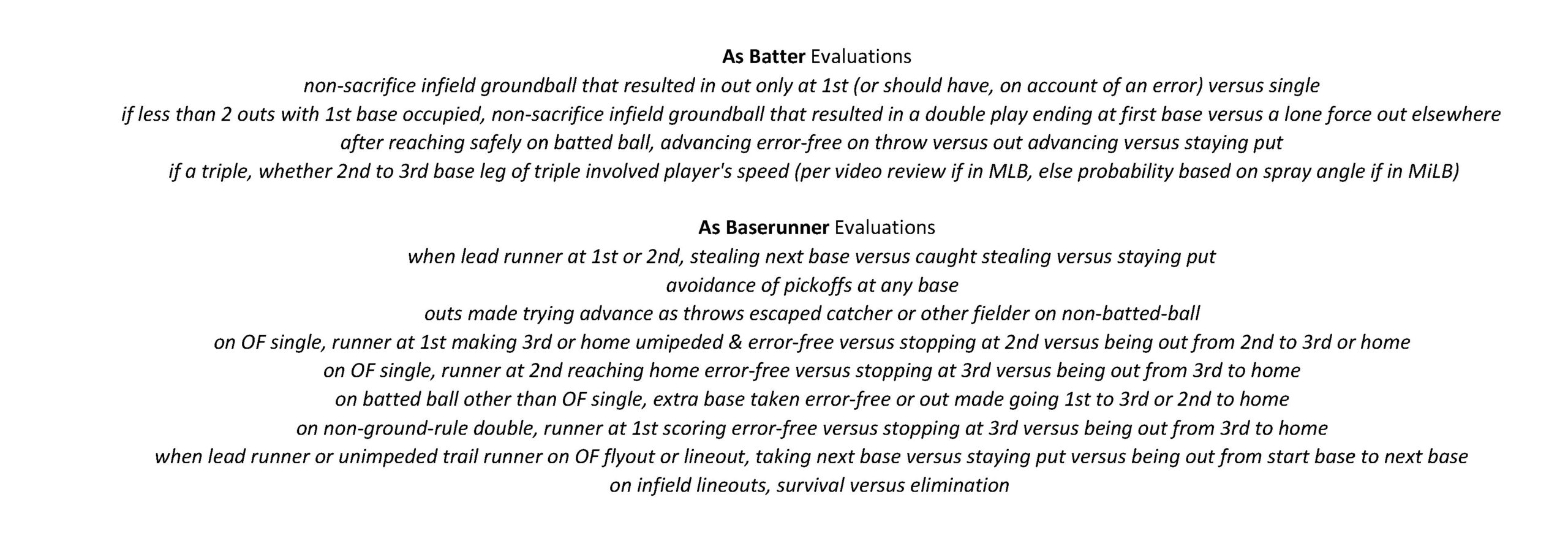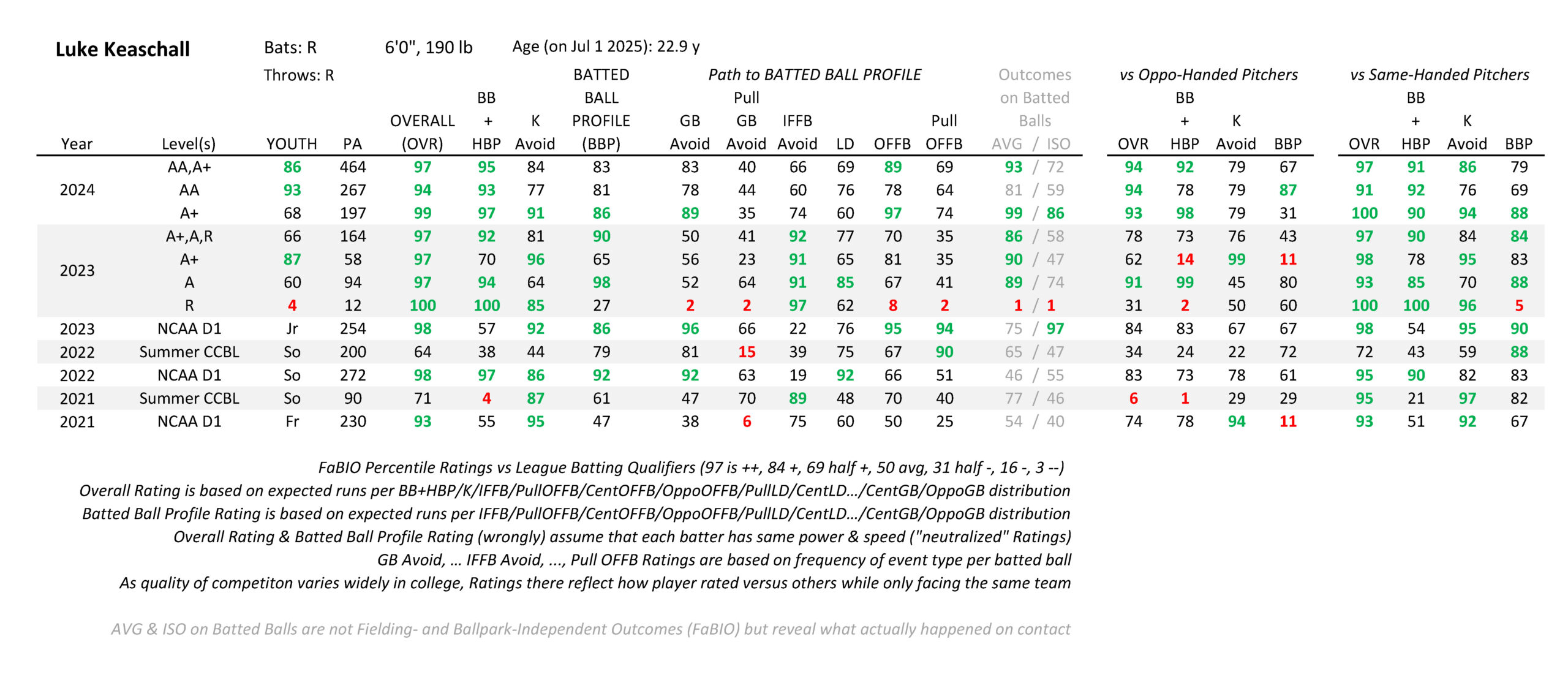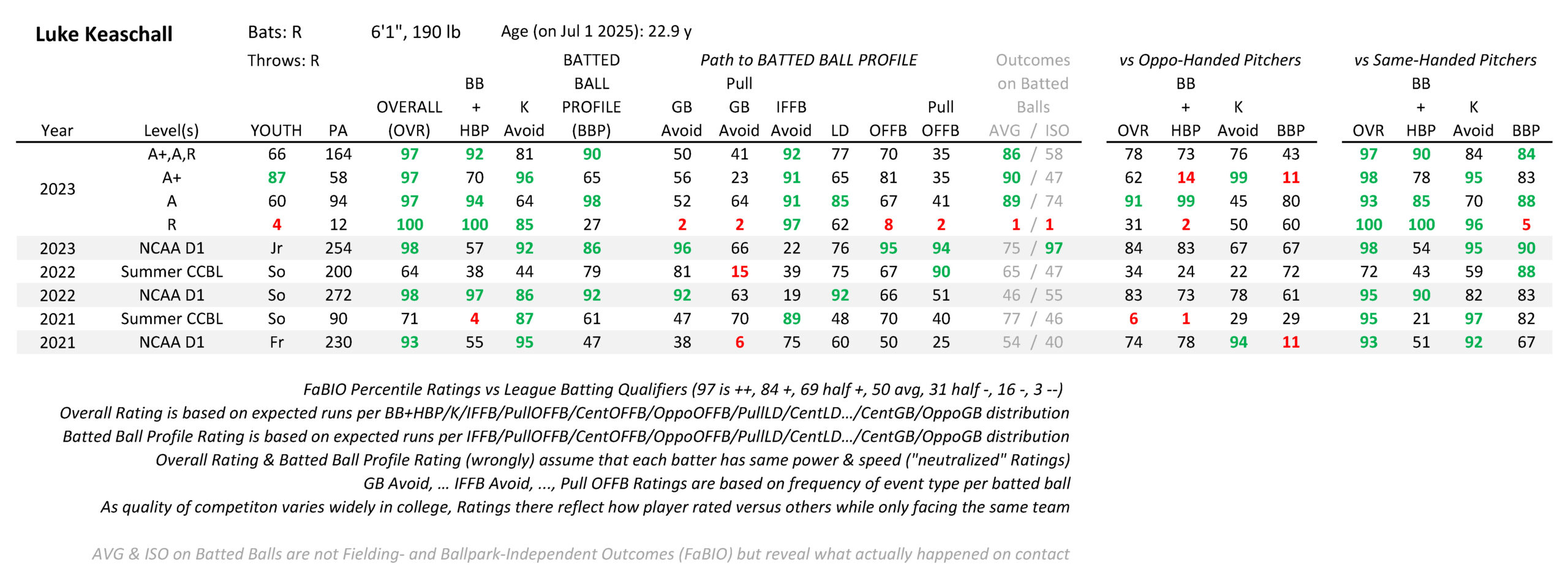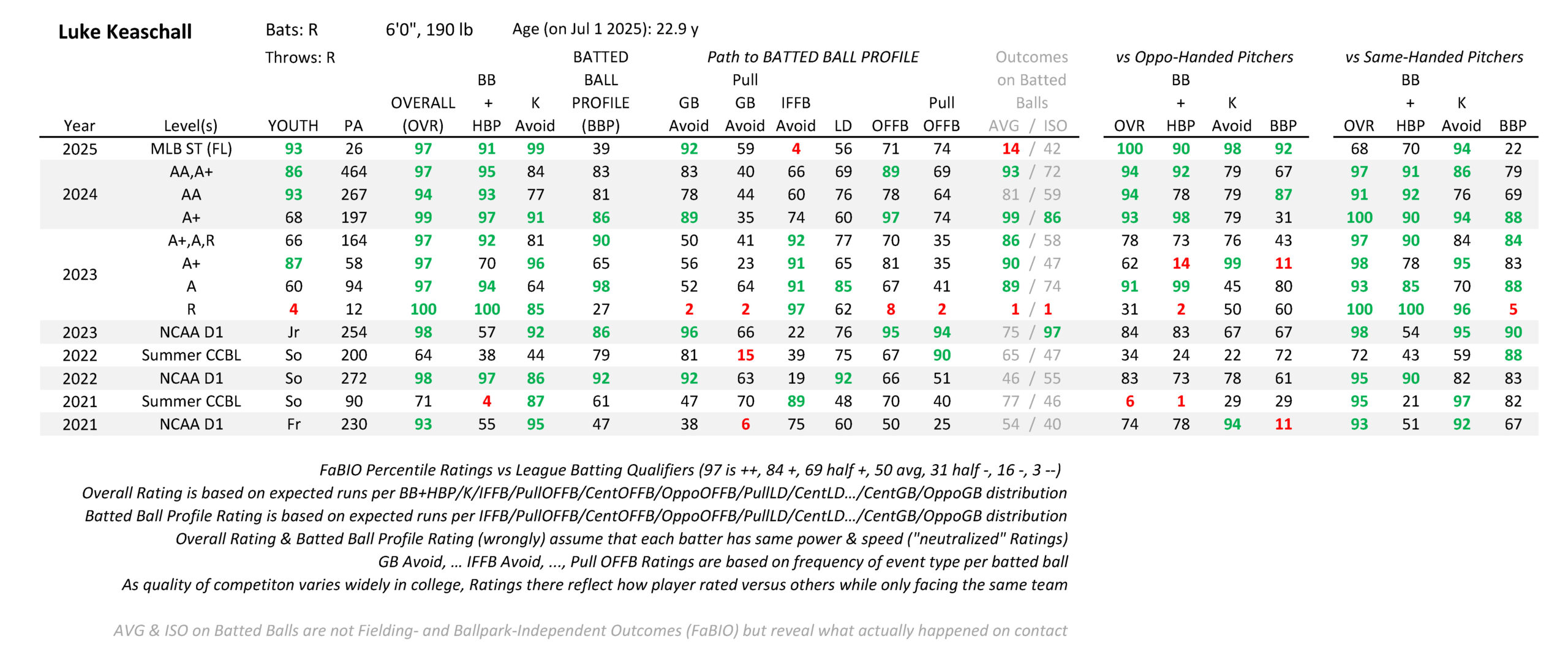Luke Keaschall's fantasy baseball prospect outlook, sleeper potential for dynasty leagues. Matt uses his custom suite of fundamentals-rooted evaluation tools.
With his selection to the major league roster of the Minnesota Twins, Luke Keaschall becomes who I believe to be the sixth 2025 MLB rookie position player from the 2023 MLB Draft class (another two position players from the class lost rookie status during 2024).
A longer run of broadly strong plate fundamentals dates back to his 2021 NCAA Division 1 (D1) freshman season.
What should dynasty league fantasy owners focus on when examining the offensive profile of Keaschall?
Be sure to check all of our fantasy baseball lineup tools and resources:- Fantasy baseball trade analyzer
- BvP matchups data (Batter vs. Pitcher)
- PvB matchups data (Pitcher vs. Batter)
- Who should I start? Fantasy baseball comparisons
- Daily MLB starting lineups
- Fantasy baseball closer depth charts
- Fantasy Baseball live scoreboard
- Fantasy baseball injury reports
Brief Explanation of the FaBIO Model
My Fielding- and Ballpark-Independent Outcomes (FaBIO) evaluation model sorts every plate appearance into one of 12 outcome bins (BB+HBP, K, IFFB, Pull-Third OFFB, Center-Third OFFB, Oppo-Third OFFB, Pull-Third LD, Center-Third LD, Oppo-Third LD, Pull-Third GB, Center-Third GB, Oppo-Third GB) and charges the pitcher and batter with their league's mean runs value for said particular event that season.
Dividing a batter's total number of expected runs by plate appearance (PA) yields expected runs per PA that can be percentile ranked relative to the league mean and standard deviation for that parameter amongst league batter qualifiers to arrive at their Overall Rating.
Its three subcomponents of BB+HBP Rating (based on BB+HBP per PA), Strikeout Avoid Rating (K Avoid, based on K per PA), and Batted Ball Profile Rating (expected runs per batted ball) are also reported to identify the path the batter traveled to reach their Overall Rating.
Overall Rating and Batted Ball Profile Rating of batters should be considered power- and speed-neutralized metrics since the real-world runs value of a single batter's typical OFFB or LD varies with their strength, and the expected runs value of their typical GB varies with their speed.
To better understand the Path to Batted Ball Profile, we will also examine percentile ratings for select batted ball event types (on a per-batted ball basis). To check how well expected batted ball outcomes match real-world ones, we will compute percentile ratings for hits (AVG) and isolated power (ISO, or simply extra bases) on batted balls (recognizing full well that these two parameters are neither fielding- nor ballpark-independent outcomes).
What most explains a batter's ability to generate hits (AVG) on batted balls is any LD, IFFB avoidance, Pull-Third OFFB, and Pull-Third GB avoidance. What most explains their ability to generate extra bases (ISO) on batted balls is any OFFB, Pull-Third OFFB, Pull-Third LD, and IFFB avoidance.
A percentile rating of 97 amounts to plus-plus (two standard deviations above the mean), 84 is plus (one standard deviation above the mean), 69 is half plus, 50 is average, 31 is half minus, 16 is minus, and three is minus-minus.
A new addition to this suite of evaluation models is the Offensive Running Rating. This tool quantifies how each relevant inning's run expectancy was impacted by the player's action or inaction as either a batter or baserunner on specific types of plays that are more likely to involve one or both of their speed, offensive running technique, and acumen.
The evaluated batter and baserunner events are summarized in the graphic.
Prospect Analysis: Luke Keaschall
Evolution of College Plate Profile
Keaschall played his first two NCAA D1 seasons at the University of San Francisco. In between, he started his first collegiate summer by logging about the same number of plate appearances in the non-FaBIO-ed Cal Ripken Collegiate League as he later did in the prestigious Cape Cod Baseball League. Along came the portal, and he transferred to Arizona State for his junior and first collegiate draft-eligible season.
Larger batted ball profile fundamentals gains were made from 2021 D1 to 2022 D1 but loudness of batted ball outcomes held around average per similar AVG and ISO Ratings. The lack of bat physicality would show up in 2023 D1 play with Arizona State via 75 AVG and 97 ISO Ratings as the Path to Batted Ball Profile remained similar to the one from 2022 D1 aside from adding more OFFB and Pull OFFB.
K Avoid stayed in the plus to double plus range over all three D1 seasons. BB+HBP spiked to double plus in 2022 D1 but else rated just above average in the other two D1 seasons. The righthanded batter posted backward pitcher handedness splits in all three springs and both summers, as Overalls versus Same-Handed Pitchers always beat those versus Oppo-Handed Pitchers.
Intrigued by a broader mix of good offensive fundamentals and prospective infielder-outfielder defensive versatility, the Twins selected Keaschall in the second round (49th overall) of the 2023 MLB Draft and signed him at a $1.5 million bonus.
Evolution of Pro Plate Profile
After 12 tune-up PA in the Rookie-level Florida Complex League, Keaschall was assigned to the Low-A affiliate for 94 PA over which he produced roughly double plus BB+HBP and Batted Ball Profile Ratings sandwiched an almost half plus K Avoid. The magnitudes virtually flipped over 58 High-A PA in which a double plus K Avoid was sandwiched by half plus BB+HBP and Batted Ball Profile Ratings.
Over the full three-level 2023 pro debut, Keaschall put up above plus BB+HBP outcomes, below plus K Avoid outcomes, and an above plus hit-over-power-design batted ball profile that naturally produced more AVG than ISO on batted balls.
In both Low-A and High-A, relatively many OFFB begat relatively few Pull OFFB. That late bias to OFFB spray limited ISO more in High-A than it did in Low-A. Like in each college row, Overall was higher versus Same-Handed Pitchers than versus Oppo-Handed Pitchers.
Keaschall added batted ball profile loft in 2024 (note the higher GB Avoid and OFFB Ratings then versus 2023 MiLB) and translated the extra OFFB and Pull OFFB into increased ISO production. He would sacrifice some LD + IFFB Avoid as a negative consequence but paid no toll in loss of AVG on Batted Balls versus 2023 MiLB.
 2024 BB+HBP and K Avoid Ratings remained very on par with the strong 2023 MiLB marks. In a relative surprise, Oppo-Handed Pitchers Overall rather matched Same-Handed Pitchers Overall at both 2024 stops as the righthanded batter seemed to get more comfortable while facing lefthanders.
2024 BB+HBP and K Avoid Ratings remained very on par with the strong 2023 MiLB marks. In a relative surprise, Oppo-Handed Pitchers Overall rather matched Same-Handed Pitchers Overall at both 2024 stops as the righthanded batter seemed to get more comfortable while facing lefthanders.
Keaschall posted stellar (91) BB+HBP and (99) K Avoid Ratings over 26 plate trips of 2025 MLB spring game action. Batted Ball Profile rated subpar mostly due to a surplus of IFFB, as else he struggled to translate LD + Pull OFFB into AVG and convert OFFB + Pull OFFB into ISO.
Improvements realized in Oppo-Handed Pitchers outcomes during 2024 very translated to the very small sample of 2025 MLB spring play.
Evolution of Pro Offensive Running
In the three-level 2023 pro debut, Keaschall posted a double plus 97 Offensive Running Rating that was led by a 100 as Baserunner Rating.
In his High-A and Double-A 2024, Keaschall managed a not quite half plus 65 Offensive Running Rating in which a nearly plus 83 as Batter Rating comfortably topped a just over half minus 35 as Baserunner Rating.
Keaschall should be at least a half plus offensive runner ahead and perhaps a full plus one if he can rectify whatever ailed his 2024 as Baserunner Rating.
Dynasty Fantasy Baseball Focus
Keaschall profiles as a solid to good at everything player who would tend to fly under the radar for lack of any overly impressive trait. He should be viewed as a prospective steadier positive contributor on real-world and fantasy rosters alike.
In wake of 267 higher-caliber Double-A plate appearances to end 2024 that have since been followed by 26 MLB spring PA that leaned BB+HBP with K Avoid and another 58 solid-enough Triple-A PA, Keaschall may be ready to "plate pest" his way to better non-batted-ball outcomes but is unlikelier to emerge as a producer of louder MLB batted balls so soon.
He probably needs at least a month to three of further Triple-A seasoning to build a base for later transformation into a solid to better near-everyday MLB regular.
At MLB maturation, Keaschall would project for plus combined walks and hit by pitches, half to full plus strikeouts, half to full plus batted ball profile fundamentals, half to full plus hits on batted balls, average extra bases on batted balls, half plus offensive running.
Keaschall has mostly played second base and center field as a pro and else first base. As he has only logged one pro game at his initial two college season primary positions of third base and shortstop, any bonus fantasy positional versatility is likely limited to moving him freely between the outfield and right side of the infield.
Download Our Free News & Alerts Mobile App
Like what you see? Download our updated fantasy baseball app for iPhone and Android with 24x7 player news, injury alerts, sleepers, prospects & more. All free!

More Fantasy Baseball Advice
 RADIO
RADIO




























